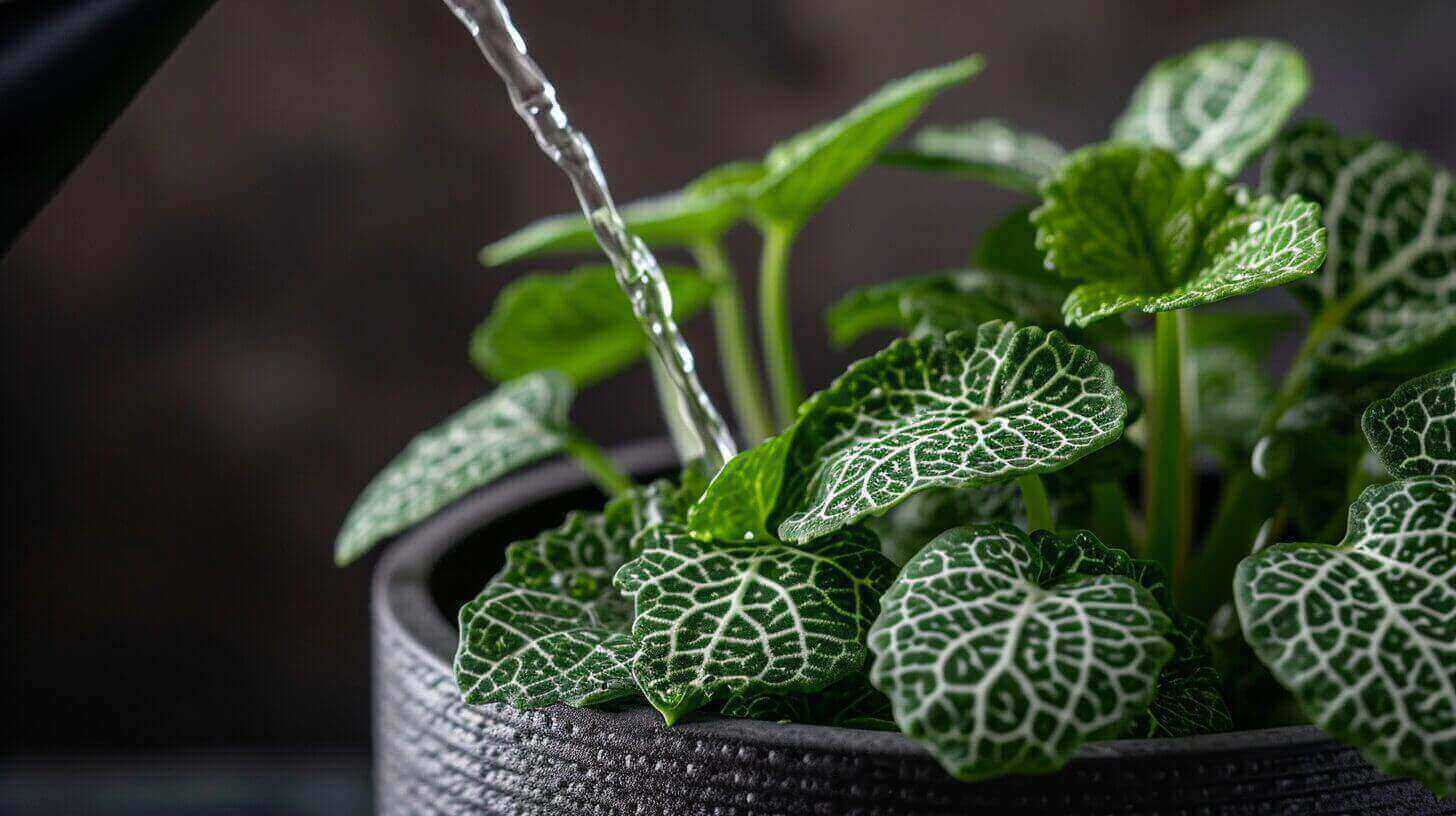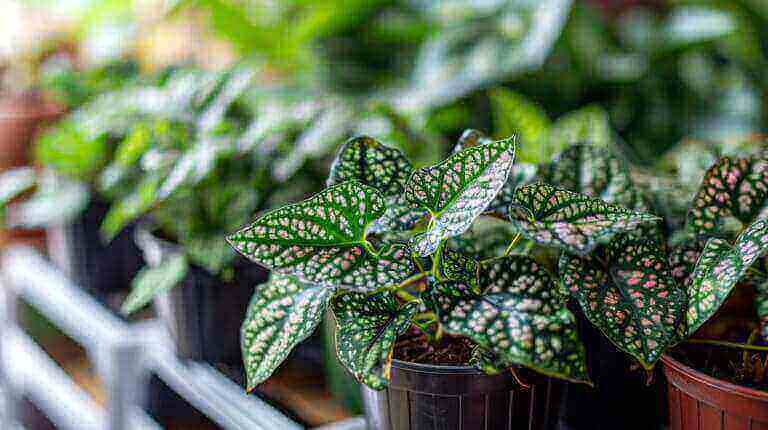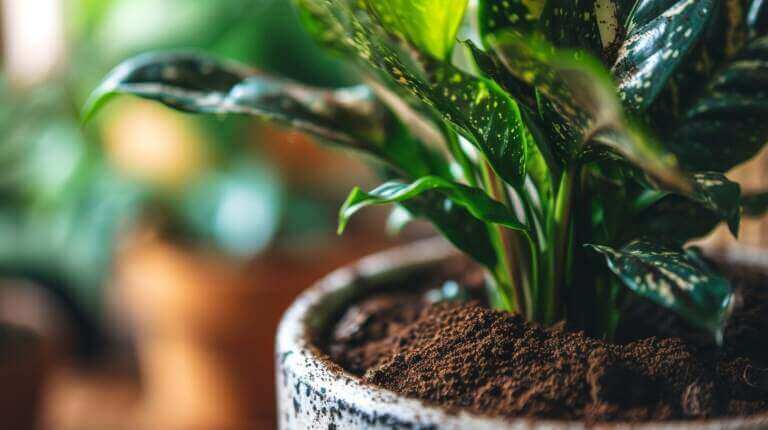Fittonia Nerve Plants Water Needs: Watering Amount, Frequency, and Best Practices
Nerve plants, also known as Fittonia, are popular for their striking foliage and easy-to-care-for nature. However, improper watering techniques can lead to issues like yellow or crispy leaves, ultimately affecting the plant’s health and appearance. In this section, I will guide you through the best practices for watering your nerve plants, including the ideal amount of water, frequency of watering, and expert tips for optimal care.
Key Takeaways:
- Proper watering is essential for the health and appearance of nerve plants.
- The ideal amount of water depends on various factors like the plant’s size, soil type, and humidity levels.
- Overwatering can lead to root rot, while underwatering can cause the leaves to wilt and dry out.
- It’s essential to adjust the watering frequency based on the plant’s needs and observe for signs of stress or nutrient deficiencies.
- Expert tips like using room temperature water and avoiding wetting the leaves can help ensure optimal care for your nerve plants.
Understanding Nerve Plants: Care Guide and Water Needs
In this section, I will provide an overview of nerve plants, also known as Fittonia, and their care guide, including their water needs.
Nerve plants are tropical houseplants that are native to parts of South America. They are known for their striking foliage, which features intricate patterns of veins on their leaves. These plants are relatively easy to care for, but they do have specific requirements that are essential for their growth and well-being.
Nerve Plant Care Guide
Here are the important factors to consider when caring for your nerve plants:
- Light: Nerve plants prefer bright, indirect light. Direct sunlight can burn their leaves, causing irreversible damage.
- Temperature: These plants thrive in warm temperatures, ideally between 60 and 80 degrees Fahrenheit.
- Humidity: Nerve plants require high humidity levels to thrive. You can increase humidity by misting the leaves with water or placing a humidifier near the plant.
- Soil: These plants need well-draining soil that has plenty of organic matter to help retain moisture.
Water Needs
Proper watering is crucial for the health of your nerve plants. Here are some tips to help you meet their water needs:
- Watering frequency: Nerve plants require consistently moist soil, but they are also susceptible to root rot if they are overwatered. Water your nerve plant when the top inch of soil feels dry to the touch.
- Watering amount: When watering your nerve plant, aim to thoroughly saturate the soil. Avoid allowing the plant to sit in standing water, as this can lead to root rot.
- Water source: It’s best to use distilled or filtered water when watering your nerve plant, as they are sensitive to chemicals found in tap water.
Watering Frequency for Nerve Plants: How Often is Ideal?
As mentioned in the previous section, understanding your nerve plant’s water requirements is crucial to ensure its good health. The frequency of watering depends on several factors, such as humidity levels, temperature, and soil type. In general, nerve plants prefer consistent moisture in their soil, but overwatering can be just as damaging as underwatering.
The recommended watering schedule for nerve plants is once a week or when the top inch of soil feels dry to the touch. However, this can vary depending on your plant’s location and environmental conditions. For example, nerve plants in a hot and dry room may require more frequent watering than those in a cool and humid area.
Another factor to consider is the size of your pot. The larger the pot, the more soil it contains, and the longer it takes to dry out. Keep in mind that overwatering can lead to root rot and other issues that can harm your plant.
One way to determine if your plant needs watering is by checking its leaves. Nerve plants will wilt slightly when they need water, signaling that it’s time to water. However, don’t wait until the leaves start to droop before watering, as this can stress the plant.
Fittonia Plant Watering Techniques and Best Practices
Watering your nerve plant is an essential aspect of plant care that ensures its survival and longevity. Adopting the right watering techniques and practices can help maintain the health and beauty of your plants. Below are some tips on how to water your nerve plant effectively:
Use room temperature water:
Avoid using cold water that can shock the roots or hot water that can scorch the leaves. Room temperature water is ideal for nerve plants and can prevent stress and damage.
Water thoroughly:
Ensure that the water reaches the roots and moistens the soil completely. This can help prevent dry spots in the soil that can lead to root rot.
Use well-draining soil:
Nerve plants require soil that drains well to prevent waterlogging that can lead to overwatering. Using a well-draining potting mix or adding perlite or sand to the soil can improve drainage.
Don’t let the soil dry out completely:
Nerve plants are sensitive to underwatering, and letting the soil dry out completely can lead to stress and damage. Check the soil moisture regularly and water the plant when the soil feels slightly dry to the touch.
Use a watering can or a spray bottle:
Depending on the size of your plant, using a watering can or a spray bottle can help control the amount of water you give it. A watering can is ideal for larger plants, while a spray bottle can be used for smaller ones.
Watch for signs of overwatering:
Overwatering can be detrimental to nerve plants and cause root rot, yellow leaves, or stunted growth. If you notice any of these signs, reduce the watering frequency and adjust the amount of water you give your plant.
Adjust your watering schedule:
The frequency of watering your nerve plant can vary depending on factors such as humidity, temperature, and light exposure. Adjust your watering schedule accordingly and observe your plant for any signs of stress or nutrient deficiencies.
Troubleshooting Watering Issues: Common Problems and Solutions
Even with the best watering practices, nerve plants can still face issues related to water. Here are some of the most common watering problems and solutions to help your plants thrive:
Yellow Leaves
If the leaves of your nerve plant are turning yellow, it may be a sign of overwatering. Too much water can cause root rot and other issues, leading to yellowing leaves.
To fix this issue, start by reducing your watering frequency. Let the soil dry out a bit before watering again and make sure that your pot has proper drainage. You can also consider repotting your plant in fresh, well-draining soil.
Crispy Leaves
Crispy or browned leaves on your nerve plant are often a sign of underwatering. When the soil is too dry, the leaves will start to dry out and turn brown.
To remedy this issue, make sure you are watering your plant regularly and thoroughly. Check the soil frequently to ensure it stays moist but not waterlogged. You can also consider misting the leaves with water or placing a humidifier near your plant to help increase humidity.
Overwatering
Overwatering is a common problem with nerve plants, as they are sensitive to too much water. Signs of overwatering include yellowing leaves, wilting, and a musty smell.
If you suspect that you are overwatering your plant, reduce your watering frequency and allow the soil to dry out more between waterings. Make sure your pot has adequate drainage and consider repotting in fresh soil if necessary.
Underwatering
As mentioned above, underwatering can cause crispy or browned leaves. Other signs of underwatering include wilting and drooping foliage.
To prevent underwatering, make sure you are watering your plant regularly and thoroughly. Check the soil frequently and water when the top inch of soil is dry to the touch.
Plant Care Tips
Here are some additional tips to help prevent watering issues with your nerve plants:
- Only water when necessary: Overwatering can be just as detrimental as underwatering. Make sure you are checking the soil before watering and only give your plant water when it needs it.
- Use room-temperature water: Cold water can shock the roots of your plant, while too-hot water can damage them. Use room-temperature water to prevent any issues.
- Consider a moisture meter: If you are unsure about when to water your plant, a moisture meter can help take the guesswork out of the process.
“Watering can be a tricky process, but with a little knowledge and practice, you can keep your nerve plants thriving and beautiful.”
FAQ
When should I repot my Fittonia nerve plant?
You should consider repotting your Fittonia nerve plant when you notice that your nerve plant is outgrowing its current pot or if the plant isn’t looking as healthy as it should. This is usually a sign that the plant is getting too big for its pot and needs more space to grow.
What are some general Fittonia care tips?
Fittonia, also known as the nerve plant, is a tropical plant that loves high humidity and indirect light. Regular watering is essential, but be careful not to give the plant excess water. The green leaves of the Fittonia albivenis will tell you if the plant is happy – they should be vibrant and lush.
How do I care for Fittonia in a pot?
When caring for Fittonia in a pot, ensure the pot has good drainage to prevent excess water from sitting at the base of the plant. Place the nerve plant in a location with indirect light, as too much direct sunlight can harm the plant.
How often should I water my nerve plant?
Water your Fittonia when the top inch of soil feels dry to the touch. Be careful not to overwater, as this can lead to root rot. If you notice that your nerve plant’s leaves might be yellowing or wilting, it could be a sign of overwatering.
How should I fertilize my nerve plant?
Fertilize your nerve plant every two weeks during the growing season (spring and summer) with a balanced houseplant fertilizer. This will help keep your Fittonia happy and promote the growth of new leaves.
How many Fittonia plants should I keep together?
You can keep many plants together in a terrarium or a large pot to create a mini indoor plant jungle. Fittonia plants grow well together as they have similar care requirements.
What should I do if my Fittonia has yellow leaves?
Yellow leaves might be a sign that your plant is receiving too much light or water. Move your plant to a location with less direct light and reduce watering. If the problem persists, you may need to repot the plant.
How do I propagate my Fittonia?
Fittonia can be propagated by taking stem cuttings. Cut a part of the plant with a few leaves, place it in water until roots form, then plant it in soil. This is a great way to grow this plant and have more Fittonia plants.







